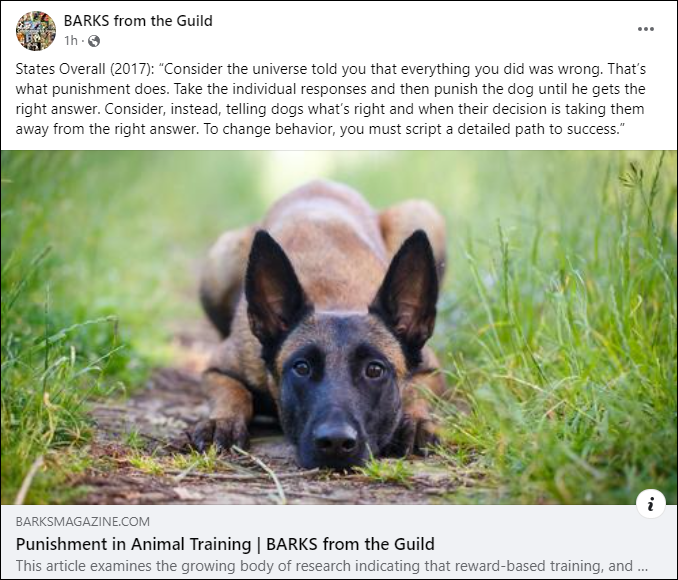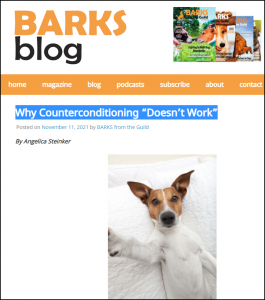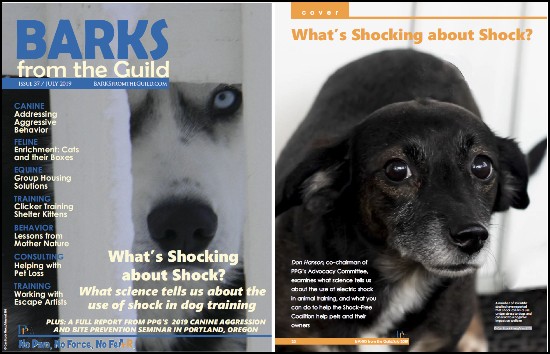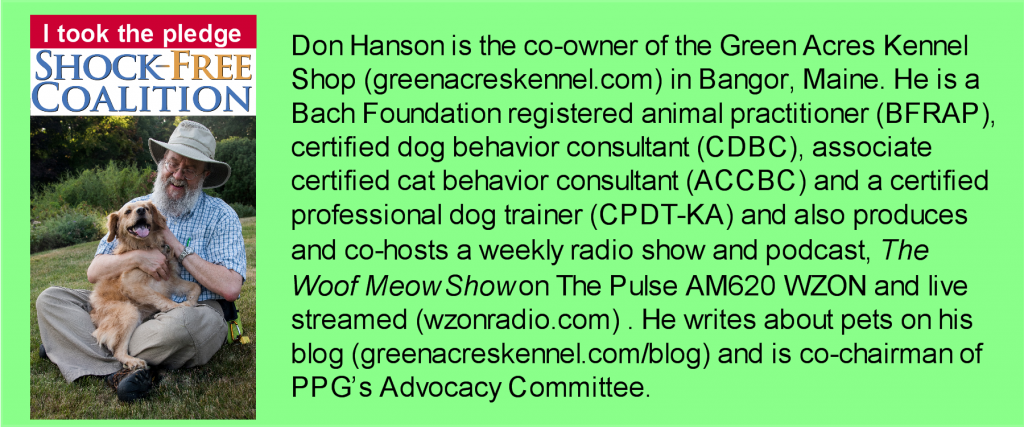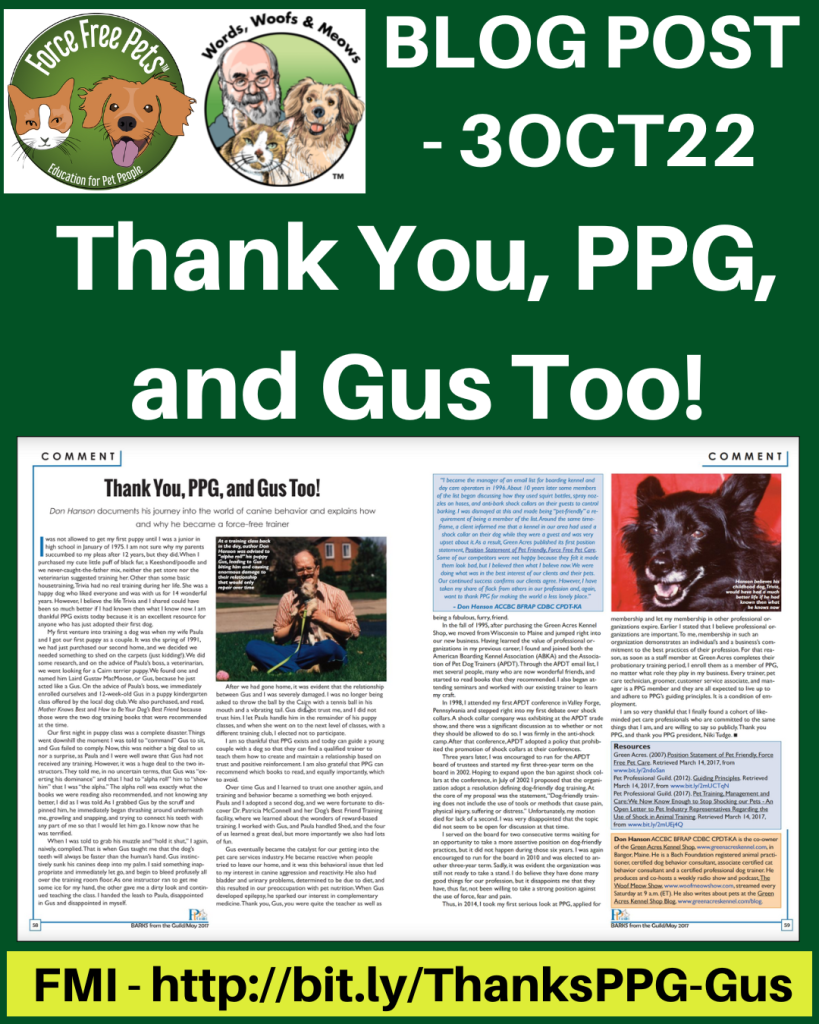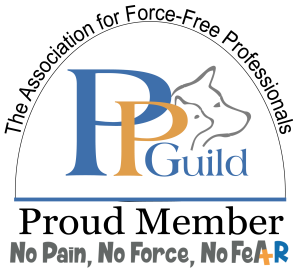If you care for animals, please read this excellent article from BARKS from the Guild on why punishment in animal training is not only totally unnecessary but also has great potential to be extremely harmful. Then share it with others, including those pet care professionals who still recommend punishment. If they choose not to read because “they know it all,” they have just demonstrated they know very little. We can stop hurting animals if we all work together and take a stand. Thank you for helping. – https://barksmagazine.com/article/punishment-in-animal-training/?
Tag: BARKS from the Guild
Podcast – Understanding, Identifying, and Coping with Canine Stress
 < Click to Listen to Podcast >
< Click to Listen to Podcast >
< Updated 17NOV21 >
< A short link for this page – https://bit.ly/WfMw-09OCT21-CanineStress >
In this episode of The Woof Meow Show from October 9th, 2021, Kate and Don discuss Don’s article, Understanding, Identifying, and Coping with Canine Stress, published in the July 2021 issue of BARKS from the Guild and at https://barksfromtheguild.com/article/understanding-identifying-and-coping-with-canine-stress/
< Click to Listen to Podcast >
Contact Info
Don Hanson & Kate Dutra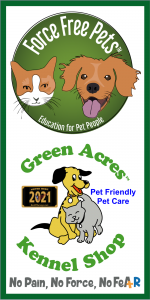
Green Acres Kennel Shop, ForceFreePets.com & The Woof Meow Show
Address: 1653 Union St, Bangor, ME 04401-2204
Phone: (207) 945-6841, x103
Email–Email Don
Website-Green Acres: https://www.greenacreskennel.com/
Facebook-Green Acres: https://www.facebook.com/GreenAcresKennelShop/
Website-The Woof Meow Show: https://woofmeowshow.libsyn.com/
Facebook-The Woof Meow Show: https://www.facebook.com/WoofMeowShow/
Website-ForceFreePets–https://forcefreepets.com/
Facebook-ForceFreePets–https://www.facebook.com/ForceFreePets
Recommended Resources
Articles on Don’s Blog
( http://www.words-woofs-meows.com )
Understanding, Identifying, and Coping with Canine Stress – http://bit.ly/Canine-Stress, and July 2021 issue of BARKS from the Guild and at https://barksfromtheguild.com/article/understanding-identifying-and-coping-with-canine-stress/
Animal Welfare – Assessing Pets’ Welfare Using Brambell’s Five Freedoms – http://bit.ly/Brambells-APDT2014
Do I Need a Dog Trainer or a “Behaviorist”? – http://bit.ly/WWM-Trainer-Behaviorist
Dominance: Reality or Myth – http://bit.ly/Dominance-RealityorMyth
Helping Your Dog Thrive with Brambell’s Five Freedoms – http://bit.ly/Brambell-1thru5-PDF
Help! My Dog is Aggressive, Reactive, Fearful, Anxious, etc. – What do I do? – WWM – APR2017 – http://bit.ly/HelpDogAggx
How Can I Tell When My Dog Is Anxious or Fearful? – http://bit.ly/DogsSignsofFear
How to Choose a Dog Trainer – http://bit.ly/HowToChooseADogTrainer
Introduction to Canine Communication – http://bit.ly/CanineComm
Understanding Behavior; Why It Matters – http://bit.ly/AnimalWelfare-Behavior
Management of An Aggressive, Fearful or Reactive Dog – http://bit.ly/BhxManagement
Puppy Socialization and Habituation – http://bit.ly/SocializationPuppy
Reward Based Training versus Aversives – http://bit.ly/RewardVSAversive
What Is A Pet Behavior Consultant? – http://bit.ly/WhatIsPetBhxConsulting
What Is Dog Training – http://bit.ly/WhatIsDogTraining
Your Pet’s Behavioral Health Is As Important As Their Physical Well-Being: The New AAHA Canine and Feline Behavior Management Guidelines – http://bit.ly/WWM_AAHA_Bhx
 Podcasts from The Woof Meow Show
Podcasts from The Woof Meow Show
( http://woofmeowshow.libsyn.com/ )
Canine Behavior: Myths and Facts – http://bit.ly/WfMwK9Bhx-26MAR16
Pet Behavior, Vets & The AAHA Canine and Feline Behavior Management Guidelines with Dr. Dave Cloutier – http://bit.ly/WfMw-AAHA-Guidelines-13MAR16
The Dominance and Alpha Myth (2010) – http://bit.ly/WfMw-Dominance-2010
Other Online Resources
American Animal Hospital Association (2015.) AAHA Canine and Feline Behavior Management Guidelines – https://www.aaha.org/aaha-guidelines/behavior-management/behavior-management-home/
BCSPCA. (2016, June 28). Tip Tuesday: Tips for dealing with dog reactivity – https://www.youtube.com/watch?v=j1J8uuJi0Ys
Garrod, D. (2019, November). Stress Matters. BARKS from the Guild (39) 36-39 – https://issuu.com/petprofessionalguild/docs/bftg_november_2019_online_edition_x_opt/36
Pet Professional Guild Finding A Professional (2020) – https://www.petprofessionalguild.com/Zip-Code-Search
Pet Professional Guild Guiding Principles (2012) – https://www.petprofessionalguild.com/Guiding-Principles
Pet Professional Guild Position Statements (2012-2019) – https://www.petprofessionalguild.com/Position-Statements
Turid Rugaas – Calming Signals – The Art of Survival (2013) – http://en.turid-rugaas.no/calming-signals—the-art-of-survival.html
 Books
Books
Brambell, R. (1965). Report of the technical committee to enquire into the welfare of animals kept under intensive livestock husbandry systems. London, UK: Her Majesty’s Stationery Office.
Chin, L. (2020). Doggie Language: A Dog Lover’s Guide to Understanding Your Best Friend. Chichester, UK: Summersdale Publishers
O’Heare, J. (2005). Canine Neuropsychology, 3rd edn. Ottawa, ON: DogPsych
Rugaas, T. (2005). On Talking Terms with Dogs: Calming Signals, 2nd edn. Wenatchee, WA: Dogwise
Strong, V. (1999). The Dog’s Brain — A Simple Guide. Windsor, UK: Alpha Publishing
Tudge, N. (2017). A Kids’ Comprehensive Guide to Speaking Dog! n.p.: Doggone Safe
________________________________________________________________________
Don Hanson is the co-owner of the Green Acres Kennel Shop ( greenacreskennel.com ) in Bangor, Maine, where he has been helping people with their pets since 1995. He is also the founder of ForceFreePets.com, an online educational resource for people with dogs and cats. Don is a Bach Foundation Registered Animal Practitioner (BFRAP), Certified Dog Behavior Consultant (CDBC), Associate Certified Cat Behavior Consultant (ACCBC), and a Certified Professional Dog Trainer (CPDT-KA). He is a member of the Pet Professional Guild (PPG). Don serves on the PPG Board of Directors and Steering Committee. In addition, he chairs the Advocacy Committee and The Shock-Free Coalition ( shockfree.org ). Don produces and co-hosts a weekly radio show and podcast, The Woof Meow Show, that airs on Z62 Retro Radio WZON (AM620) and WKIT 103.3-HD3 and is streamed at http://bit.ly/AM620-WZON every Saturday at 9 AM. Podcasts of the show are available at http://bit.ly/WfMwPodcasts/, the Apple Podcast app, and Don’s blog: www.words-woofs-meows.com. The opinions in this post are those of Don Hanson.
Shared Blog Post – Why Counterconditioning “Doesn’t Work” or How to Help Ensure Counterconditioning Will Work
Angelica Steinker of Courteous Canine, Inc. wrote a brilliant article entitled Why Counterconditioning “Doesn’t Work” for the May 2015 issue of BARKS from the Guild, the professional journal of the Pet Professional Guild. Today the article was posted on the BARKS blog. My only criticism is, I think a better title would have been “How to Help Ensure Counterconditioning Will Work.”
In this article, the author discusses the typical reason a counterconditioning protocol fails; user error. In my experience, far too often, people with a fearful pet are in such a hurry to help their pet that they miss the keys to success that Steinker outlines in her article. The steps she describes can dramatically increase the odds of counterconditioning relieving the dog’s anxiety. The core message is the animal being counter conditioned MUST feel safe and relaxed.
This is a MUST READ for anyone working with fearful animals.
< Click here to read on the BARKS blog >
Recommended Resources
Articles on Don’s Blog
( http://www.words-woofs-meows.com )
Help! My Dog is Aggressive, Reactive, Fearful, Anxious, etc. – What do I do? – http://bit.ly/HelpDogAggx
How Can I Tell When My Dog Is Anxious or Fearful? – http://bit.ly/DogsSignsofFear
Introduction to Canine Communication – http://bit.ly/CanineComm
Understanding, Identifying and Coping with Canine Stress – http://bit.ly/Canine-Stress
Management of An Aggressive, Fearful or Reactive Dog – http://bit.ly/BhxManagement
Shared Blog Post – the misunderstanding of time by Nancy Tanner – http://blog.greenacreskennel.com/2016/11/16/shared-blog-post-the-misunderstanding-of-time-by-nancy-tanner/
The emotional toll of a reactive dog by Jay Gurden in Dog’s Today – http://bit.ly/SharedGurenEmotional
Podcasts from The Woof Meow Show
( http://woofmeowshow.libsyn.com/ )
Anxiety, Fears & Phobias with Dr. Christine Calder – https://bit.ly/WfMw-AnxFrPhbiaDrCalder
________________________________________________________________________
Don Hanson is the co-owner of the Green Acres Kennel Shop ( greenacreskennel.com ) in Bangor, Maine, where he has been helping people with their pets since 1995. He is also the founder of ForceFreePets.com, an online educational resource for people with dogs and cats. Don is a Bach Foundation Registered Animal Practitioner (BFRAP), Certified Dog Behavior Consultant (CDBC), Associate Certified Cat Behavior Consultant (ACCBC), and a Certified Professional Dog Trainer (CPDT-KA). He is a member of the Pet Professional Guild (PPG), where he serves on the Board of Directors and Steering Committee and chairs the Advocacy Committee and The Shock-Free Coalition ( shockfree.org ). Don produces and co-hosts a weekly radio show and podcast, The Woof Meow Show, that airs on Z62 Retro Radio WZON (AM620) and WKIT 103.3-HD3 and is streamed at http://bit.ly/AM620-WZON every Saturday at 9 AM. Podcasts of the show are available at http://bit.ly/WfMwPodcasts/, the Apple Podcast app, and Don’s blog: www.words-woofs-meows.com. The opinions in this post are those of Don Hanson.
©11NOV21, Donald J. Hanson, All Rights Reserved
< Click for Copyright and Use Policy >
Podcast – Charlee and the Electronic Shock Containment System w-Dan Antolec
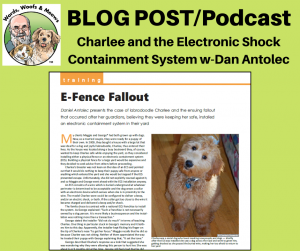 < Click to Listen to Podcast >
< Click to Listen to Podcast >
< Updated 19APR20 >
< A short link for this page –
insert link – https://bit.ly/Blog-Charlee_E-Fence >
Have you ever thought about using a shock collar with your dog, or do you currently use one? Do you know someone that does? Please, listen to this podcast to learn about the dangerous fallout that can occur when using electric shock to train or contain your dog.
In this episode of The Woof Meow Show from April 18th, 2020, Don Hanson talks with Dan Antolec, Co-Chair of the Shock-Free Coalition and the owner of Happy Buddha Dog Training in Brooklyn, Wisconsin. Don and Dan are both credentialed professional dog trainers and dog behavior consultants committed to pet care that is free of pain, force, and fear. They serve on the Pet Professional Guild Steering Committee and co-chair the Shock-Free Coalition.
In this podcast, we discuss Antolec’s article E-Fence Fallout, which appeared in the March 2020 issue of BARKS from the Guild, the official publication of the Pet Professional Guild. The subject of the article is a dog named Charlee. Charlee’s guardians sought Dan’s advice after installing an Electronic Shock Containment System, also called a non-visible fence, which severely and negatively affected Charlee’s behavior and quality of life.
Topics we discuss include the lack of knowledge of the “professional” installer who sold the system and the franchise’s failure to disclose potential side-effects of using a shock collar. We will reveal how the system failed to keep Charlee in her yard as advertised and made her afraid to come back into her yard and safety. Dan will describe how a malfunction by the shock collar caused Charlee to be shocked while simply relaxing calming in her own home. Lastly, we discuss how the shock and the benign sound that reveals a shock is imminent, caused Charlee to become afraid. The painful shock soon became associated with a wide variety of sounds heard in Charlee’s environment regularly. Soon she was always anticipating another painful shock and living in constant fear. We also discuss some of the many peer-reviewed scientific articles that warn of the use of electric shock for the purpose of training, behavior change, or containment. Charlee’s story is painful, but it is a story that Charlee’s guardians and Dan wanted people to hear so that we can end the use of these abusive and dangerous tools.
If you would like to join us at the Shock-Free Coalition and help us stop the use of shock collars, please take the pledge, as an individual or business, and at no cost to you at, https://www.shockfree.org/Pledge. You can go a step further and order some Shock-Free merchandise at the coalition online store at – https://pet-professional-guild.myshopify.com/collections/all?page=3
If you wish to report that your pet has been exposed to a Shock-Collar by a Pet Professional without your explicit knowledge and approval, you may do so at https://www.shockfree.org/Shock-Collar-Use
You can hear The Woof Meow Show on Z62 Retro Radio, AM620, and WKIT HD3 at 9 AM on Saturday. If you are not near a radio, listen on your computer at http://bit.ly/AM620-WZON or your smartphone or tablet with the free WZON 620 AM app. A podcast of the show is typically posted immediately after the show. You can download this show and others at http://bit.ly/WfMwPodcasts , at Don’s blog http://bit.ly/Words-Woofs-Meows and the Apple iTunes store.
Contact Info
Business: Happy Buddha Dog Training, Brooklyn, WI
Website: https://www.happybuddhadogtraining.com/
Facebook Page: https://www.facebook.com/HappyBuddhaDogTraining/
Recommended Resources
Articles on Don’s Blog
( http://bit.ly/Words-Woofs-Meows )
What’s Shocking about Shock? – What Science Tells Us About the Use of Shock in Dog Training – PPG BARKS from the Guild – July 2019 – http://bit.ly/ShockBARK-JUL2019
The Unintended Consequences of Shock Collars – http://bit.ly/ShockCollars
Is Your Dog Your Best Friend or a Family Member? – WWM-OCT2017 – http://bit.ly/BestFriendsAndShock
Shared Blog Post – The Tucson Dog – Arizona Region Shock-Free Coalition – http://bit.ly/Shared-TucsonDogFEB2019
About Don – http://bit.ly/AboutDonHanson
 Podcasts from The Woof Meow Show
Podcasts from The Woof Meow Show
( http://bit.ly/WfMwPodcasts )
The Unintended Consequences of Shock Collars – http://bit.ly/ShockPodcast
The Pet Professional Guild and the Shock-Free Coalition with Niki Tudge – http://bit.ly/PodCastShockFree-NikiTudge-2017
What’s Shocking About Shock – What Science Tells Us About the Use of Shock in Dog Training – http://bit.ly/WfMw-WhatShock-27JUL19
Other Resources
BARKS from the Guild
( https://barksfromtheguild.com/ ) 
E-Fence Fallout by Daniel Antolec – https://barksfromtheguild.com/2020/04/16/e-fence-fallout
“I Will Never Use the Shock Collar Again!” by Eileen Anderson – https://barksfromtheguild.com/2019/11/28/i-will-never-use-the-shock-collar-again/
The Problem with Shock by Angelica Steinker – https://barksfromtheguild.com/2019/12/16/the-problem-with-shock/
The Unintended Consequences of Shock by Dan Antolec – https://barksfromtheguild.com/2018/05/13/the-unintended-consequences-of-shock/
What’s Shocking about Shock? – What Science Tells Us About the Use of Shock in Dog Training by Don Hanson – https://barksfromtheguild.com/article/whats-shocking-about-shock/
 The Pet Professional Guild
The Pet Professional Guild
( https://www.petprofessionalguild.com/ )
Guiding Principles – http://bit.ly/PPG-GuidingPrinciples
The Use of Shock in Animal Training – https://www.petprofessionalguild.com/shockcollars
Pet Training, Management and Care: We Now Know Enough to Stop Shocking Our Pets – An Open Letter to Pet Industry Representatives Regarding the Use of Shock in Animal Training – http://bit.ly/2mUEj4Q
The Shock-Free Coalition
( https://www.shockfree.org/ )
Take the Shock-Free Pledge – https://www.shockfree.org/Pledge
The Shock-Free Coalition Store – https://pet-professional-guild.myshopify.com/collections/all?page=3
The Shock-Free Coalition on Facebook – https://www.facebook.com/shockfreecoalition/
The Shock-Free Coalition-Maine on Facebook – http://bit.ly/ShockFreeMEFB
Report Shock Collar Abuse – https://www.shockfree.org/Shock-Collar-Use
©19APR20, Donald J. Hanson, All Rights Reserved
< Click for Copyright and Use Policy >
Podcast – What’s Shocking About Shock – What Science Tells Us About the Use of Shock in Dog Training
< A short link to this post – http://bit.ly/WfMw-WhatShock-27JUL19 >
< Click to Listen to Podcast >
 In this episode of The Woof Meow Show from July 27th, 2019 Kate interviews Don, asking him about his article, What’s Shocking About Shock – What Science Tells Us About the Use of Shock in Dog Training, published in the July 2019 issue of BARKS from The Guild, the journal of the Pet Professional Guild (PPG).
In this episode of The Woof Meow Show from July 27th, 2019 Kate interviews Don, asking him about his article, What’s Shocking About Shock – What Science Tells Us About the Use of Shock in Dog Training, published in the July 2019 issue of BARKS from The Guild, the journal of the Pet Professional Guild (PPG).
The use of electric shock for training, containing, and caring for dogs is extremely controversial. In this podcast we examine and discuss what peer-reviewed scientific studies report about the use of shock and answer four common questions; Does electric shock hurt?, Is electric shock more efficient for training dogs than reward-based training?, Is electric shock necessary for training behaviors like snake aversion?, and Does electric shock save dogs lives? Additionally, we review the formal positions taken on the use of shock by several organizations of pet care professionals from around the globe, and also examine the countries where the use of shock has already been banned.
If you are using shock or contemplating using shock you will want to hear what science says by listening to this show/podcast; your dog’s health and welfare may depend on you understanding this controversial tool and its harmful side effects. We also recommend you also read Don’s article and all of the scientific studies that he cites in the article, all of which you can link to at Don’s blog at http://bit.ly/ShockBARK-JUL2019.
You can hear The Woof Meow Show on Z62 Retro Radio, AM620, and WKIT HD3 at 9 AM on Saturday. If you are not near a radio, listen on your computer at http://bit.ly/AM620-WZON or your smartphone or tablet with the free WZON 620 AM app. A podcast of the show is typically posted immediately after the show. You can download this show and others at http://woofmeowshow.libsyn.com/, at Don’s blog http://bit.ly/Words-Woofs-Meows and the Apple iTunes store.
< Click to Listen to Podcast >
References
American Animal Hospital Association. (2019). AAHA behavior guidelines offer solutions to managing behavior problems with your pet. Available at: http://bit.ly/AAHABhx2015
Anderson, E. (2012). What is Shock Training? – Is It Really Just A Tap? Shock Collar Training Explained. Available at: http://bit.ly/SHOCK-Anderson-WhatIsShock
Blackwell, E.J., Bolster, C., Richards, G., Loftus, B.A., & Casey, R.A. (2012). The use of electronic collars for training domestic dogs: estimated prevalence, reasons and risk factors for use, and owner perceived success as compared to other training methods. BMC Veterinary Research (8) 93. Available at: http://bit.ly/SHOCK-Blackwell-BMCVR-2012
Brewer, P. (2019). Do let the dogs out: Huge fines for pet confinement part of ACT animal welfare overhaul. Available at: http://bit.ly/2Wx0Qu8
British Columbia Society for the Prevention of Cruelty to Animals. (2019). Position Statement on Animal Training. Available at: http://bit.ly/2XEb8W2
British Small Animal Veterinary Association. (2019). Position Statement on Aversive Training Methods. Available at: http://bit.ly/2F0HdAa
British Veterinary Association. (2018). Aversive training devices for dogs. Available at: http://bit.ly/2XByUlv
Canadian Veterinary Medical Association. (2015). Humane Training Methods for Dogs – Position Statement. Available at: http://bit.ly/2KHCcQr
Department for Environment, Food and Rural Affairs. (2010). Studies to assess the effect of pet training aids, specifically remote static pulse systems, on the welfare of domestic dogs: Project Code AW1402. Available at: http://bit.ly/SHOCK-DEFRA-AW1402-2013
Department for Environment, Food and Rural Affairs. (2011). Studies to assess the effect of pet training aids, specifically remote static pulse systems, on the welfare of domestic dogs; field study of dogs in training: Project Code AW1402a. Available at: http://bit.ly/SHOCK-DEFRA-AW1402a-2013
European Society of Veterinary Clinical Ethology. (2017). ESVCE Position Statement: Electronic Training Devices. Available at: http://bit.ly/SHOCK-ESVE_Pos
Hiby, E.F., Rooney, N.J., & Bradshaw, J.W.S. (2004). Dog training methods—their use, effectiveness and interaction with behaviour and welfare. Animal Welfare (13) 63–69. Available at: http://bit.ly/SHOCK-Hiby-AnimWelfare-2004
New Zealand Veterinary Association. (2018). Use of behaviour modifying collars on dogs. Available at: http://bit.ly/2F1z6Dj
Pet Professional Guild. (2012). Guiding Principles. Available at: http://bit.ly/PPG-GuidingPrinciples
Polsky, R. (2000). Can Aggression in Dogs Be Elicited Through the Use of Electronic Pet Containment Systems? Journal of Applied Animal Welfare Science 3 (4) 345‐357. Available at: http://bit.ly/SHOCK-Polsky-JAAWS-Aggx-2000
Sandgrain Films. (2017). Shock Collar [Video File]. Available at: http://vimeo.com/235106629
Schalke, E., Stichnoth, J., & Jones‐Baade, R. (2005). Stress symptoms caused by the use of electric training collars on dogs (Canis familiaris) in everyday life situations. Current Issues and Research in Veterinary Behavioral Medicine. 5th International Veterinary Behavior Meeting. West Lafayette, Indiana: Purdue University Press, 139‐145.
Schalke, E., Stichnoth, J., Ott, S., & Jones‐Baade, R. (2007). Clinical signs caused by the use of electric training collars on dogs in everyday life situations. Applied Animal Behaviour Science 105 (4) 369‐380. Available at: http://bit.ly/SHOCK-Schalke-AABS-JUL2007
Schilder, M., & van der Borg, J. (2004). Training dogs with help of the shock collar: short and long term behavioural effects. Applied Animal Behaviour Science (85) 319–334. Available at: http://bit.ly/SHOCK-Schilder-AABS-MAR2004
Shock‐Free Coalition. (2019). Myths and Misconceptions. Available at: https://www.shockfree.org/Education/Myths-and-Misconceptions
The Kennel Club. (2018). The Kennel Club and Scottish Kennel Club Welcomes the Scottish Government’s Effective Ban on Shock Training Devices. Available at: http://bit.ly/31r1Zm7
Tudge, N.J, & Nilson, S.J. (2016). The Use of Shock in Animal Training. Available at: https://www.petprofessionalguild.com/shockcollars
Tudge, N.J, Nilson, S.J., Millikan, D.A., & Stapleton‐Frappell, L.A. (2019). Pet Training and Behavior Consulting: A Model for Raising the Bar to Protect Professionals, Pets and Their People. (n.p.): DogNostics Career Center Publishing – https://petindustryregulation.com/
Yin, S. (2011). Are Electronic Shock Collars Painful – A New Study Reveals Some Answers. Available at: http://bit.ly/SHOCK-Yin-Pain-2011
Yin, S. (2012). How Technology from 30 Years Ago is Helping Military Dogs Perform Better Now. Available at: http://bit.ly/POS-REI-SpyCats
Resources
American Animal Hospital Association (AAHA) 2015 Canine and Feline Behavior Management Guidelines: http://bit.ly/AAHABhx2015
European Society of Veterinary Clinical Ethology ‐ Position Statement on Electronic Training Devices: http://bit.ly/SHOCK-ESVE_Pos
Pet Professional Guild ‐ Rattlesnake Avoidance Training Using Force‐Free Methods [Webinar]: https://petprofessionalguild.com/event-1913569
Pet Professional Guild ‐ Member Search: http://bit.ly/PPG-Find-A-Prof
Pet Professional Guild ‐ Position on Shock Training: https://www.petprofessionalguild.com/shockcollars
Shock‐Free Coalition: https://www.shockfree.org/
Shock‐Free Coalition Pledge: https://www.shockfree.org/Pledge
Other Related Resources
Articles on Don’s Blog
( http://www.words-woofs-meows.com )
Hanson, D. (2004-2018). The Unintended Consequences of Shock Collars, Available at: http://bit.ly/ShockCollars
Hanson, D. (2018) Helping Your Dog Thrive with Brambell’s Five Freedoms, Available at: Brambell’s Five Freedoms
Hanson, D. (2018, 2019). Things I Wish I Had Known…, Available at: http://bit.ly/ThingsIWishIHadKnown
Hanson, D. (2006). Green Acres’ First Statement on Being A Pet Friendly-Facility, Available at: http://bit.ly/GAKS1stPetFriendly
Hanson, D. (2006). Green Acres Kennel Shop Position Statement on Pet Friendly, Force-Free Pet Care, Available at: http://bit.ly/GAKS_Pet-Friendly
Hanson, D. (2018). The Shock-Free Coalition: What’s Next?, Don Hanson explains how to keep the momentum going once you have signed the Shock-Free Pledge, http://bit.ly/BARKS-ShockFreeMAR2018
Hanson, D. (2018) Celebrating the 1st Year of the Shock-Free Coalition – +R Rocks, Available at: http://bit.ly/Shock-FreeRocks
Podcasts from The Woof Meow Show
( http://www.woofmeowshow.com )
Podcast – The Unintended Consequences of Shock Collars – http://bit.ly/ShockPodcast
Podcast – The Woof Meow Show: The Pet Professional Guild and the Shock-Free Coalition with Niki Tudge – http://bit.ly/PodCastShockFree-NikiTudge-2017
©27JUL19, Donald J. Hanson, All Rights Reserved
< Click for Copyright and Use Policy >
What’s Shocking about Shock – What Science Tells Us About the Use of Shock in Dog Training
< A short link to this post – http://bit.ly/ShockBARK-JUL2019 >
< UPDATED – 27JUL19 >
< A short link to a podcast on this topic – http://bit.ly/WfMw-WhatShock-27JUL19 >
< The original version of this article was published in the July 2019 issue of Barks from the Guild, a publication of the Pet Professional Guild. >You may read it in its original format by clicking here, or you may download a printable PDF file by clicking here.
The Pet Professional Guild (PPG) was founded in 2012 by current president, Niki Tudge. As a dog training and pet care professional, Tudge, like many of us, was discouraged by the flawed and harmful information being disseminated around the profession, including by some trainers, day care operators, groomers, boarding kennels, breeders, shelters, rescues, veterinarians, and even “reality” television shows. In some cases, the latter were promoted as offering “expert” dog training advice, but were, in fact, just like most “reality” TV: entertainment based on conflict and drama.
From its inception, PPG has been committed to the training, care, and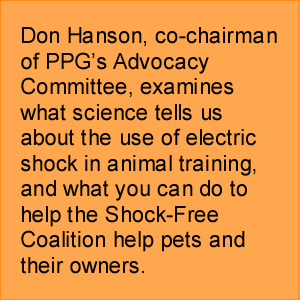 management of companion animals that are free from pain, force, and fear. Its Guiding Principles (2012) state that members are obligated to follow this philosophy: “To be in any way affiliated with the Pet Professional Guild, all members must adhere to a strict code of conduct. Pet Professional Guild members understand Force-Free to mean: No shock, No pain, No choke, No fear, No physical force, No compulsion based methods are ever employed to train or care for a pet.” [Emphasis added]
management of companion animals that are free from pain, force, and fear. Its Guiding Principles (2012) state that members are obligated to follow this philosophy: “To be in any way affiliated with the Pet Professional Guild, all members must adhere to a strict code of conduct. Pet Professional Guild members understand Force-Free to mean: No shock, No pain, No choke, No fear, No physical force, No compulsion based methods are ever employed to train or care for a pet.” [Emphasis added]
This guarantee to kind, compassionate and scientific training methods is why I am a member of PPG and why the Find A Professional section of the PPG website is the first place I go when looking to refer to another pet care professional. Whoever I recommend reflects on my reputation and that of my business, so it is essential I know that those receiving my referrals are committed to training, care, and management that comply with PPG’s Guiding Principles.
In January 2015, the PPG Advocacy Committee was born with its mission defined thus: “To reduce or eliminate the practice of using 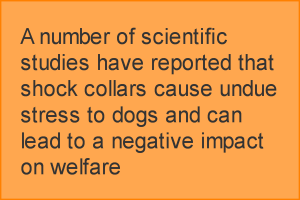 electronic shock devices in the training of domestic pet animals. PPG will achieve this goal through strategic professional, respectful and energetic processes of advocacy and education. These efforts will at all times adhere to the Guiding Principles of PPG and will be accomplished through the development of specific action plans, as determined by members of the PPG Advocacy Committee.”
electronic shock devices in the training of domestic pet animals. PPG will achieve this goal through strategic professional, respectful and energetic processes of advocacy and education. These efforts will at all times adhere to the Guiding Principles of PPG and will be accomplished through the development of specific action plans, as determined by members of the PPG Advocacy Committee.”
Key to this plan was to use the existing and developing scientific literature, demonstrating that using shock to train animals is unnecessary and often harmful and not in the interest of animal welfare, as a foundation. Next came the Shock-Free Coalition, established in September 2017, a child of the Advocacy Committee, but a separate entity with its own website and a very clear mission: “The key purpose of the Shock-Free Coalition is to build a strong and broad movement committed to eliminating shock devices from the supply and demand chain. This goal will be reached when shock tools and equipment are universally unavailable and not permitted for the training, management and care of pets.”
Critical steps in this process are:
- To engage and educate pet owners and shelter/rescue workers to help them make informed decisions about the management, care, and training of the pets in their charge.
- To build a worldwide coalition that provides pet owners access to competent, professional pet industry service providers.
- To create widespread pet industry transparency and compliance regarding how professionals implement their services and communicate their philosophy to pet owners.
- The Shock-Free Coalition website serves as an educational resource for anyone wanting to learn more about the organization and why ending the use of shock is so essential. It also offers anyone the opportunity to support the cause by taking the Shock-Free Pledge,
 either as an individual or as a business. Participants may pledge at several different levels ranging from simply signing the pledge to signing the pledge and making a recurring financial contribution to help the mission continue toward its goal.
either as an individual or as a business. Participants may pledge at several different levels ranging from simply signing the pledge to signing the pledge and making a recurring financial contribution to help the mission continue toward its goal.
What Does Science Tell Us about Shock?
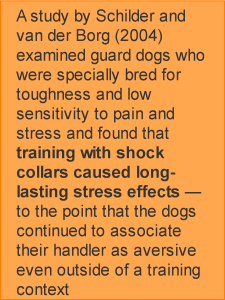 The Shock-Free Coalition did not come to its conclusion that using shock for the training, care, and management of pets was unnecessary and harmful out of the blue. Its position is based on the careful review of the growing number of peer reviewed, scientific studies that demonstrate that shock is not only unnecessary, but is harmful, both physically and psychologically.
The Shock-Free Coalition did not come to its conclusion that using shock for the training, care, and management of pets was unnecessary and harmful out of the blue. Its position is based on the careful review of the growing number of peer reviewed, scientific studies that demonstrate that shock is not only unnecessary, but is harmful, both physically and psychologically.
What Do the Professional Organizations Say?
The current scientific data, in addition to the moral and ethical concerns about mental and physical damage to animals subjected to methods using force, fear and/or pain have moved a number of representing professional organizations to advocate for the use of humane training techniques founded on evidence-based learning theories and avoid training methods or devices which employ coercion, pain, force and/or fear (Tudge & Nilson, 2016). These include, but are not limited to:
- “The American Animal Hospital Association (AAHA) guidelines oppose aversive training techniques, such as prong (pinch) or choke collars, cattle prods, alpha rolls (forcibly rolling a pet on his or her back), electronic shock collars, entrapment, and physically punishing a pet. The guidelines
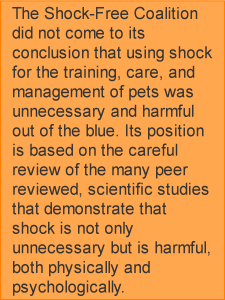 note that aversive training techniques can harm or even destroy an animal’s trust in his or her owner, negatively impact the pet’s problem-solving ability, and cause increased anxiety in the animal. Aversive techniques are especially a concern if pets are already fearful or aggressive, rendering any aggressive dog more dangerous. According to the AAHA guidelines, the only acceptable training techniques are non-aversive, positive techniques that rely on the identification of, and reward for, desirable behaviors. Positive reinforcement is the most humane and effective approach.” – American Animal Hospital Association (2015).
note that aversive training techniques can harm or even destroy an animal’s trust in his or her owner, negatively impact the pet’s problem-solving ability, and cause increased anxiety in the animal. Aversive techniques are especially a concern if pets are already fearful or aggressive, rendering any aggressive dog more dangerous. According to the AAHA guidelines, the only acceptable training techniques are non-aversive, positive techniques that rely on the identification of, and reward for, desirable behaviors. Positive reinforcement is the most humane and effective approach.” – American Animal Hospital Association (2015). - “The Canadian Veterinary Medical Association (CVMA) supports the use of humane training methods for dogs that are based on current scientific knowledge of learning theory. Reward-based methods are highly recommended. Aversive methods are strongly discouraged as they may cause fear, distress, anxiety, pain or physical injury to the dog.” – – Canadian Veterinary Medical Association (2015).
- “Aversive, punishment-based techniques may alter behaviour, but the methods fail to address the underlying cause and, in the case of unwanted behaviour, can lead to undue anxiety, fear, distress, pain or injury.” – British Columbia Society for the Prevention of Cruelty to Animals (2019).
- The British Small Animal Veterinary Association (BSAVA) “recommends against the use of electronic shock collars and other aversive methods for the training and containment of animals. Shocks and other aversive stimuli received during training may not only be acutely stressful, painful and frightening for the animals, but may also produce long term adverse effects on behavioural and emotional responses…The BSAVA strongly recommends the use of positive reinforcement training methods that could replace those using aversive stimuli.” – British Small Animal Veterinary Association (2019).
- “The British Veterinary Association (BVA) has concerns about the use of aversive training devices to control, train or punish dogs. The use of devices such as electronic collars, as a means of punishing or controlling behaviour of companion animals is open to potential abuse and incorrect use of such training aids has the potential to cause welfare and training problems…Electric pulse devices are sometimes used in dog training as a form of punishment to prevent a dog from repeating bad behaviour. Although training a dog is important for their well-being, research shows that electric pulse collars are no more effective than positive reinforcement methods. BVA has consulted with experts and examined the evidence. Research by Schalke, Stichnoth and Jones-Baade (2005) showed that the application of electric stimulus, even at a low level, can cause physiological and behavioral responses associated with stress, pain and fear. In light of the evidence, BVA has concluded that electric pulse collars raise a number of welfare issues, such as the difficulty in accurately judging the level of electric pulse to apply to a dog without causing unnecessary suffering.” – British Veterinary Association (2018).
- “The New Zealand Veterinary Association (NZVA) does not support the use of electronic behaviour modifying collars (e-collars) that deliver aversive stimuli for the training or containment of dogs. E-collars have the potential to harm both the physical and mental health of dogs. They are an aversive training method that have in some studies been associated with significant negative animal welfare outcomes. Positive reinforcement training methods are an effective and humane alternative to e-collars for dog training…The use of pain to train dogs is no more acceptable or humane when it is administered by remote control, than if it was delivered as a physical blow such as a punch or kick.” – New Zealand Veterinary Association (2018).
- “E-collar training is associated with numerous well documented risks concerning dog health, behavior and welfare. Any existing behaviour problem is likely to deteriorate or an additional problem is likely to emerge, when such a collar is used. This becomes an even greater risk when this aversive tool is used by an unqualified trainer (as training is largely unregulated throughout the EU, it appears that a large number of trainers are unqualified). Additionally, the efficacy of these collars has not been proven to be more effective than other alternatives such as positive training. Hence, European Society of Veterinary Clinical Ethology (ESVCE) encourages education programmes which employ positive reinforcement methods (while avoiding positive punishment and negative reinforcement) thereby promoting positive dog welfare and a humane, ethical and moral approach to dog training at all times.” – European Society of Veterinary Clinical Ethology (2017).
- In addition to these professional bodies, several countries, including England, Wales, Austria, Germany, Switzerland, Slovenia, Denmark, Sweden, Norway and Finland, the province of Quebec in Canada, and the states of New South Wales, South Australia and the Australian Capital Territory (ACT) in Australia, have already banned electronic stimulation devices. Under recent amendments to ACT animal welfare legislation, anyone who places an electric shock device, such as a shock collar, on an animal, will attract a maximum penalty of AU$16,000 [$11,000] and a year’s imprisonment (Brewer, 2019). In Scotland, “strict guidance” has been published by the Scottish Parliament which provides “advice on training methods and training aids for dogs, with particular focus on the welfare issues that may arise from the use of aversive methods including e-collars. It highlights the potential consequences of the misuse of aversive training aids, including possible legal consequences.” (The Kennel Club, 2018) (Tudge, Nilson, Millikan & Stapleton-Frappell, 2019).
 Examining Arguments
Examining Arguments
Meanwhile, there are pet care professionals, pet owners, and moneyed interests, such as the companies that manufacture and sell shock collars, who disregard all the research and advocate for the continued use of shock. Common arguments include that the shock “does not cause pain or discomfort” and therefore cannot be abusive or inhumane; shock is “more efficient” for training than positive reinforcement training; shock is the “only way” certain behaviors can be trained (e.g., snake avoidance training); and using shock “saves dogs’ lives.” Let’s now look at each of those arguments individually and examine them from a scientific perspective.
#1: Does the electric shock from a shock collar cause pain? States Anderson (2012): “During the initial training period, [shock] must be painful, uncomfortable, or frightening, or it wouldn’t work. It has to have some unpleasant feeling that is robust enough to get the dog to work to make it stop.”
Science, through published peer reviewed research, is quite clear that shock collars cause pain. While proponents might call it a “stim” a “tap,” or a “static charge,” we know from the science of operant conditioning that the aversive stimulus (electric shock) must be sufficiently distressing (i.e., physical or emotionally painful) to cause a change in behavior. If it did not hurt, it would not work.
Several studies have reported that shock collars cause undue stress to dogs. A study by Schilder and van der Borg (2004) examined guard dogs who were specially bred for toughness and low sensitivity to pain and stress and found that training with shock collars caused long-lasting stress effects — to the point that the dogs continued to associate their handler as aversive even outside of a training context. The dogs exhibited behaviors associated with fear and anxiety long after they had received shocks. “The conclusions, therefore are, that being trained [with electric shock] is stressful. That receiving shocks is a painful experience to dogs, and that the dogs have learned that the presence of their owner (or his commands) announces reception of shocks, even outside of the normal training context.” (Schilder & van der Borg, 2004).
Fear and Anxiety
Late veterinarian Dr. Sophia Yin (2011) discussed this study in a post on her blog and made the following key conclusions:
- Overall, the researchers concluded that even when compared to working dogs trained using choke chain and pinch collar corrections, dogs trained with electronic shock collars showed more fear and anxiety behaviors than those trained by other traditional police dog and watch-dog methods.
- Avoidance behavior and fear postures during the shocks indicated that the shock elicited both pain and fear and therefore were not just a distraction or nuisance.
- “The enormous rewards the dogs experience during training i.e. chasing down, catching a criminal and winning the sleeve, do not counter the negative effects of getting shocked. This is in spite of the fact that handlers of non-shocked dogs admitted that they use prong collars and that their dogs experienced beatings and other harsh punishment, such as kicks or choke collar corrections.” (Yin, 2011).
An important point to note here is that shock collar users may sometimes say something along the lines of, “I don’t use the shock feature any more. I only use the collar with the beep on now.” However, the Shock-Free Coalition (2019) points out that the tone itself can become as aversive and damaging as the shock once the association has been established: “If I pull out a gun, and I cock it, are you any less scared than if I fired it? If your dog does what you ask when he hears the beep, it means that he has learned that the beep predicts a painful shock, just like cocking the gun predicts a bullet hitting you. While the collar is no longer physically hurting the dog, it can still be scarring him emotionally.”
Another study, by Schalke, Stichnoth, Ott and Jones-Baade (2007), examined the use of shock for training to stop undesirable hunting/ chasing behavior. This study also revealed that the dogs being trained with shock found it to be very stressful. The authors concluded, “…the general use of electric shock collars is not consistent with animal welfare.”
A third study, AW1402, conducted by the University of Lincoln and the University of Bristol for DEFRA in the United Kingdom (2010), compared the features of several shock collars and examined how they are typically used by pet owners. The researchers concluded that “for a subset of dogs tested, the previous use of e-collars in training are associated with behavioural and physiological responses that are consistent with significant negative emotional states; this was not seen to the same extent in the control population. It is therefore suggested that the use of e-collars in training pet dogs can lead to a negative impact on welfare, at least in a proportion of animals trained using this technique.”
The AW1402 researchers also observed that the instruction manuals that came with shock collar products did not provide an adequate explanation of how to use the device. When the individuals using the collars were interviewed, they could not explain how to use the collar properly and often indicated that they had failed to read the instructions or chose to ignore them. The researchers concluded that “…some of the reported use was clearly inconsistent with advice in e-collar manuals and potentially a threat to the dog’s welfare.” (DEFRA, 2010).
As noted in the AW1402 study, misuse and inappropriate use of shock collars are not uncommon. One of my employees witnessed such abuse at a field trial event. A dog owner with two dogs was working with one dog and had a second dog in his truck in a crate. The dog he was working with did not respond to a cue, so the owner pressed a button on the remote to shock the dog. The dog still did not respond to the cue, so the owner shocked the dog again. Meanwhile, the dog in the crate was yelping each time the owner intended to shock the dog he was allegedly training. It was not until our staff member pointed it out that the owner realized he was shocking the wrong dog as he was using the wrong remote unit.
Ultimately, I think the question everyone with a dog needs to ask themselves is, “Do I want to be working with a pet care professional that does not understand the basic principles of learning?” States veterinarian and veterinary behaviorist Dr. Lisa Radosta in the 2017 documentary, Dogs, Cats and Scapegoats: “If your trainer is still using pinch collars and choke collars, they haven’t read a book or gone to a scientifically based seminar in 25 years.” The sad fact is that dog training is an unregulated profession, and because of that, there are far too many people in the profession spreading disinformation about dogs, their behavior, and how to train them.
For anyone who understands how animals learn, what could be their motivation for using, recommending, and selling shock collars all the while telling people it’s not really a shock and/or it won’t hurt their dog? They are certainly not being truthful. Sadly, greed has caused humans to do unethical and unnecessary things from the beginning of time. I believe this excerpt from Dogs, Cats, and Scapegoats (2017) further illustrates my point about shock causing pain as well as the motivation for selling shock collars. It begins with Dr. Radosta’s statement cited in the previous paragraph and continues with a video of someone demonstrating a shock collar on themselves. I use this excerpt in my orientation program for all my Basic Manners students and in a presentation for my aggression clients, and it does help people understand that shock is very painful.
#2. Is training a dog with an aversive such as a shock collar more efficient than using positive reinforcement training and food? The next argument we might hear in favor of using shock is that the pain it causes is “irrelevant,” because, as a training method, it is “so much more efficient.” Well, is it?
The DEFRA AW1402 study (2010) indicates that not only does shock cause pain, it is often misused. This led to a second DEFRA study, AW1402a (2011), to assess the effect of pet training aids, specifically remote static pulse systems, on the welfare of domestic dogs. AW1402a was designed to investigate how dogs would react when a shock collar was used per the manufacturer’s instructions. The study looked at three different groups of dogs, all with owners that had reported their dog either had a poor recall or chased cars, bicycles or animals. One group of dogs was trained with a shock collar by dog trainers that had been trained by shock collar manufacturers; the second group of dogs was trained by the same dog trainers but with positive reinforcement. The last group of dogs was trained by members of the Association of Pet Dog Trainers (APDT) in the United Kingdom using positive reinforcement. The researchers found “behavioural evidence that use of e-collars negatively impacted on the welfare of some dogs during training even when training was conducted by professional trainers using relatively benign training programmes advised by e-collar advocates.” The study also demonstrated that the shock collar was no more effective at resolving r call and chasing behaviors than positive reinforcement training.
Ethics and Welfare
A study by Hiby, Rooney and Bradshaw (2004) specifically assessed the effectiveness of different training methods (positive reinforcement, positive punishment, and negative reinforcement) and how they affected a dog’s behavior. The scientists did not just look at shock as an aversive, but even evaluated vocal punishment and physical punishment. They concluded: “There are ethical concerns that dog training methods incorporating physical or verbal punishment may result in pain and/or suffering. We provide evidence that, in the general dog owning population, dogs trained using punishment are no more obedient than those trained by other means and, furthermore, they exhibit increased numbers of potentially problematic behaviours. Problematic behaviours can compromise welfare as they are often associated with an increased state of anxiety (e.g. Askew, 1996) and they can also lead the owner to relinquish the dog (Serpell, 1996). Because reward-based methods are associated with higher levels of obedience and fewer problematic behaviours, we suggest that their use is a more effective and welfare-compatible alternative to punishment for the average dog owner.” (Hiby, Rooney & Bradshaw, 2004).
A 2012 study by Blackwell, Bolster, Richards, Loftus and Casey specifically looked at the use of shock collars for training dogs, why owners used them, and how effective they were. The researchers concluded that “more owners using reward based methods for recall/chasing report a successful outcome of training than those using e-collars.” (Blackwell, Bolster, Richards, Loftus & Casey, 2012).
Aggressive Behavior: Case Studies
How can shock cause aggressive behavior? I believe most everyone understands that there are times when they have been anxious, reactive, rude, or outright aggressive when they were experiencing any type of pain or stress. Often, the target of that aggression will be whatever they are 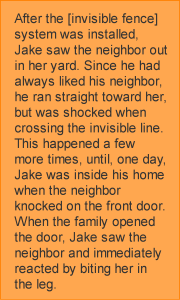 focusing on when they experience the pain. Here are two cases involving dogs that were brought to me for a behavior consultation due to aggressive behavior. In both cases, the owners believed the aggression had been caused by the use of a shock collar.
focusing on when they experience the pain. Here are two cases involving dogs that were brought to me for a behavior consultation due to aggressive behavior. In both cases, the owners believed the aggression had been caused by the use of a shock collar.
Case #1: Jake
“Jake,” a very social dog, bounded off to greet every person he saw. Jake’s guardians were concerned about him leaving the yard because he frequently went to visit the neighbors. He loved visiting with them and they enjoyed having him there. For what they believed was Jake’s protection, the family installed an underground fence system that would keep him in their yard. They trained him to the system per the manufacturer’s instructions.
After the system was installed, Jake saw the neighbor out in her yard. Since he had always liked his neighbor, he ran straight toward her, but was shocked when crossing the invisible line. This happened a few more times, until, one day, Jake was inside his home when the neighbor knocked on the front door. When the family opened the door, Jake saw the neighbor and immediately reacted by biting her in the leg.
To Jake, the neighbor was the predictor of the shock, and he now associated her with being shocked. This incident could have been pre-vented with the installation of a real fence or by supervising Jake when he was out in the yard.
Case #2: Jenny
“Jenny” would drag her guardians around on her leash, especially when she saw another dog. Jenny was just curious and friendly and wanted to greet the other dogs, but her guardians were older, and Jenny was an energetic and powerful dog. They had made no attempts to train Jenny and were frustrated with being dragged around anytime Jenny saw another dog. They went to a big box pet store where it was suggested they purchase a remote shock collar. They were instructed to shock Jenny whenever she pulled on her leash.
On their next walk, Jenny, as she always had done, moved forward in friendly greeting when she spotted another dog. Jenny was fixated on the dog she wanted to meet when she was shocked. The next time Jenny saw another dog on a walk, she immediately became anxious. As the dog approached, Jenny lunged, but this time she also growled and bared her teeth. Jenny had become very afraid. She was trying to look fierce to scare the dog away before he hurt her, when she was shocked yet again. Jenny, now anxious and confused about other dogs, learned to become aggressive because of her fear of the shock, which she associated with other dogs.
Jenny’s guardians did not train her to stop pulling; all they succeeded in doing is making a previously dog-friendly dog, dog-aggressive. If they had enrolled Jenny in a reward-based training class and made use of a front-connect walking harness, they could have taught her to walk nicely without ever causing her any pain or fear.
These are not isolated occurrences. I have training colleagues throughout the country that could tell you of similar incidents. A study by Polsky (2000) examined five cases of severe attacks by dogs who had been trained or contained via electric shock. None of the dogs had a history of aggression before being shocked. The study concludes there is a high probability that experience with shock was at least partially responsible for the aggressive behavior. This is very similar to Jake’s story.
#3. Is the use of aversives necessary to train behaviors such as snake avoidance?
Why use a shock collar if we know it can cause pain and can create previously nonexistent behavior problems like anxiety and aggression, especially when it is no more effective and often less effective than reward-based training? One answer we may often hear is that there are certain behaviors you can “only” teach a dog with an aversive like a shock. A typical behavior that is often used as an example is training a dog to stay away from rattlesnakes, or any other kind of venomous snake. While there is no peer reviewed literature to support the argument that shock is not necessary for training snake aversion, nor is there any peer reviewed literature to suggest that it is. Meanwhile, there is ample anecdotal evidence that demonstrates shock is not necessary in training more challenging behaviors. Certified professional dog trainer Pamela Johnson conducted a webinar for PPG where she explains exactly how to train your dog to be safe around snakes without resorting to the use of shock.
When it comes to teaching animals “mission critical” behaviors, far more advanced than rattlesnake aversion, one only need to look to the work done by Animal Behavior Enterprises (ABE) and the U.S. Navy Marine Mammal Training program. Marian and Bob Bailey were part of both of 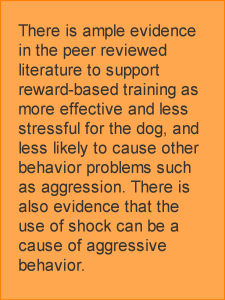 those efforts and trained animals to do many amazing things all with positive reinforcement training. Yin (2012) discusses how Bailey and Bailey continued to use their expertise to help train military dogs and also shares a little-known story about work they did in the 1960s training cats for the Central Intelligence Agency. What were the cats trained to do? To follow people through airports. If you want to learn more about how animal training moved from being a craft to a science, you might want to track down a copy of a film ABE made on the subject called Patient Like the Chipmunks.
those efforts and trained animals to do many amazing things all with positive reinforcement training. Yin (2012) discusses how Bailey and Bailey continued to use their expertise to help train military dogs and also shares a little-known story about work they did in the 1960s training cats for the Central Intelligence Agency. What were the cats trained to do? To follow people through airports. If you want to learn more about how animal training moved from being a craft to a science, you might want to track down a copy of a film ABE made on the subject called Patient Like the Chipmunks.
#4. Does using a shock collar save dogs’ lives?
Sometimes we might hear or read on social media that “using shock can save a dog’s life.” This is essentially the argument for using shock to train snake avoidance. In reality, it is a last-ditch attempt to “shock” an owner into a state of fear and anxiety, because no one wants their dog to die. The fact is there is no peer reviewed research to prove or disprove this statement, and never will be, because the design of such a study would never be approved by a review board because it would not be ethical.
How You Can Help
If the Shock-Free Coalition is going to be successful, we need the help of every single PPG member as well as all of the pet parents that want the best life possible for their furry friend. Here are some things you can do to help:
Sign the Pledge
If you are a PPG member, a pet parent, or a pet care profession and have not signed the Shock-Free Pledge), please do so! I get it, we’re all busy, and sometimes we put things on a “to do list” and then just never get to it. As a  PPG member, you have already committed to The Guiding Principles, so we know that you understand the importance of ending the use of shock collars. It is important that we get all PPG members to sign the pledge. It is equally important that we get pet parents and pet care professionals to support our call to end the use of shock for the management and training of dogs.
PPG member, you have already committed to The Guiding Principles, so we know that you understand the importance of ending the use of shock collars. It is important that we get all PPG members to sign the pledge. It is equally important that we get pet parents and pet care professionals to support our call to end the use of shock for the management and training of dogs.
Position Statements
Familiarize yourself with the PPG Position Statement on Shock Training and the AAHA Canine and Feline Behavior Management Guidelines. These two documents, especially when used together, make a compelling and scientifically sound argument for never using shock. Ask the veterinarians in your community if they are familiar with the AAHA Guidelines, especially those that are AAHA accredited facilities. If they are not, print a copy and share it with them. You might even highlight the most important parts.
Even though the ESVCE Position Statement on Electronic Training Devices focuses primarily on Europe, being one of the most recent position statements, it is a valuable resource anywhere. Ask the veterinarians in your community if they are familiar with this document and if they are not, print a copy and share it with them.
On the Web
The Shock-Free Coalition website is full of excellent information for you to review and share with others as you help spread the word about the importance of educating people about the use of shock. This material is freely available to you for when you need to speak to clients and others about the reasons for selecting positive reinforcement training as opposed to using aversives.
A special thank you to Susan Nilson, the BARKS from the Guild editor-in-chief, for her contributions to this article.
References
American Animal Hospital Association. (2019). AAHA behavior guidelines offer solutions to managing behavior problems with your pet. Available at: http://bit.ly/AAHABhx2015
Anderson, E. (2012). What is Shock Training? – Is It Really Just A Tap? Shock Collar Training Explained. Available at: http://bit.ly/SHOCK-Anderson-WhatIsShock
Blackwell, E.J., Bolster, C., Richards, G., Loftus, B.A., & Casey, R.A. (2012). The use of electronic collars for training domestic dogs: estimated prevalence, reasons and risk factors for use, and owner perceived success as compared to other training methods. BMC Veterinary Research (8) 93. Available at: http://bit.ly/SHOCK-Blackwell-BMCVR-2012
Brewer, P. (2019). Do let the dogs out: Huge fines for pet confinement part of ACT animal welfare overhaul. Available at: http://bit.ly/2Wx0Qu8
British Columbia Society for the Prevention of Cruelty to Animals. (2019). Position Statement on Animal Training. Available at: http://bit.ly/2XEb8W2
British Small Animal Veterinary Association. (2019). Position Statement on Aversive Training Methods. Available at: http://bit.ly/2F0HdAa
British Veterinary Association. (2018). Aversive training devices for dogs. Available at: http://bit.ly/2XByUlv
Canadian Veterinary Medical Association. (2015). Humane Training Methods for Dogs – Position Statement. Available at: http://bit.ly/2KHCcQr
Department for Environment, Food and Rural Affairs. (2010). Studies to assess the effect of pet training aids, specifically remote static pulse systems, on the welfare of domestic dogs: Project Code AW1402. Available at: http://bit.ly/SHOCK-DEFRA-AW1402-2013
Department for Environment, Food and Rural Affairs. (2011). Studies to assess the effect of pet training aids, specifically remote static pulse systems, on the welfare of domestic dogs; field study of dogs in training: Project Code AW1402a. Available at: http://bit.ly/SHOCK-DEFRA-AW1402a-2013
European Society of Veterinary Clinical Ethology. (2017). ESVCE Position Statement: Electronic Training Devices. Available at: http://bit.ly/SHOCK-ESVE_Pos
Hiby, E.F., Rooney, N.J., & Bradshaw, J.W.S. (2004). Dog training methods—their use, effectiveness and interaction with behaviour and welfare. Animal Welfare (13) 63–69. Available at: http://bit.ly/SHOCK-Hiby-AnimWelfare-2004
New Zealand Veterinary Association. (2018). Use of behaviour modifying collars on dogs. Available at: http://bit.ly/2F1z6Dj
Pet Professional Guild. (2012). Guiding Principles. Available at: http://bit.ly/PPG-GuidingPrinciples
Polsky, R. (2000). Can Aggression in Dogs Be Elicited Through the Use of Electronic Pet Containment Systems? Journal of Applied Animal Welfare Science 3 (4) 345‐357. Available at: http://bit.ly/SHOCK-Polsky-JAAWS-Aggx-2000
Sandgrain Films. (2017). Shock Collar [Video File]. Available at: http://vimeo.com/235106629
Schalke, E., Stichnoth, J., & Jones‐Baade, R. (2005). Stress symptoms caused by the use of electric training collars on dogs (Canis familiaris) in everyday life situations. Current Issues and Research in Veterinary Behavioral Medicine. 5th International Veterinary Behavior Meeting. West Lafayette, Indiana: Purdue University Press, 139‐145.
Schalke, E., Stichnoth, J., Ott, S., & Jones‐Baade, R. (2007). Clinical signs caused by the use of electric training collars on dogs in everyday life situations. Applied Animal Behaviour Science 105 (4) 369‐380. Available at: http://bit.ly/SHOCK-Schalke-AABS-JUL2007
Schilder, M., & van der Borg, J. (2004). Training dogs with help of the shock collar: short and long term behavioural effects. Applied Animal Behaviour Science (85) 319–334. Available at: http://bit.ly/SHOCK-Schilder-AABS-MAR2004
Shock‐Free Coalition. (2019). Myths and Misconceptions. Available at: https://www.shockfree.org/Education/Myths-and-Misconceptions
The Kennel Club. (2018). The Kennel Club and Scottish Kennel Club Welcomes the Scottish Government’s Effective Ban on Shock Training Devices. Available at: http://bit.ly/31r1Zm7
Tudge, N.J, & Nilson, S.J. (2016). The Use of Shock in Animal Training. Available at: https://www.petprofessionalguild.com/shockcollars
Tudge, N.J, Nilson, S.J., Millikan, D.A., & Stapleton‐Frappell, L.A. (2019). Pet Training and Behavior Consulting: A Model for Raising the Bar to Protect Professionals, Pets and Their People. (n.p.): DogNostics Career Center Publishing – https://petindustryregulation.com/
Yin, S. (2011). Are Electronic Shock Collars Painful – A New Study Reveals Some Answers. Available at: http://bit.ly/SHOCK-Yin-Pain-2011
Yin, S. (2012). How Technology from 30 Years Ago is Helping Military Dogs Perform Better Now. Available at: http://bit.ly/POS-REI-SpyCats
Resources
American Animal Hospital Association (AAHA) 2015 Canine and Feline Behavior Management Guidelines: http://bit.ly/AAHABhx2015
European Society of Veterinary Clinical Ethology ‐ Position Statement on Electronic Training Devices: http://bit.ly/SHOCK-ESVE_Pos
Pet Professional Guild ‐ Rattlesnake Avoidance Training Using Force‐Free Methods [Webinar]: https://petprofessionalguild.com/event-1913569
Pet Professional Guild ‐ Member Search: http://bit.ly/PPG-Find-A-Prof
Pet Professional Guild ‐ Position on Shock Training: https://www.petprofessionalguild.com/shockcollars
Shock‐Free Coalition: https://www.shockfree.org/
Shock‐Free Coalition Pledge: https://www.shockfree.org/Pledge
Other Related Resources
Articles on Don’s Blog
( http://www.words-woofs-meows.com )
Hanson, D. (2004-2018). The Unintended Consequences of Shock Collars, Available at: http://bit.ly/ShockCollars
Hanson, D. (2018) Helping Your Dog Thrive with Brambell’s Five Freedoms, Available at: Brambell’s Five Freedoms
Hanson, D. (2018, 2019). Things I Wish I Had Known…, Available at: http://bit.ly/ThingsIWishIHadKnown
Hanson, D. (2006). Green Acres’ First Statement on Being A Pet Friendly-Facility, Available at: http://bit.ly/GAKS1stPetFriendly
Hanson, D. (2006). Green Acres Kennel Shop Position Statement on Pet Friendly, Force-Free Pet Care, Available at: http://bit.ly/GAKS_Pet-Friendly
Hanson, D. (2018). The Shock-Free Coalition: What’s Next?, Don Hanson explains how to keep the momentum going once you have signed the Shock-Free Pledge, http://bit.ly/BARKS-ShockFreeMAR2018
Hanson, D. (2018) Celebrating the 1st Year of the Shock-Free Coalition – +R Rocks, Available at: http://bit.ly/Shock-FreeRocks
Podcasts from The Woof Meow Show
( http://www.woofmeowshow.com )
Podcast – What’s Shocking About Shock – What Science Tells Us About the Use of Shock in Dog Training – http://bit.ly/WfMw-WhatShock-27JUL19
Podcast – The Unintended Consequences of Shock Collars – http://bit.ly/ShockPodcast
Podcast – The Woof Meow Show: The Pet Professional Guild and the Shock-Free Coalition with Niki Tudge – http://bit.ly/PodCastShockFree-NikiTudge-2017
©27-Jul-19, Donald J. Hanson, All Rights Reserved
< Click for Copyright and Use Policy >
The Shock-Free Coalition: What’s Next?
Don Hanson explains how to keep the momentum going once you have signed the Shock-Free Pledge
<A version of this article was published in the March 2018 issue of Barks from the Guild, a publication of the Pet Professional Guild>
< A short link to this page – http://bit.ly/BARKS-ShockFreeMAR2018 >
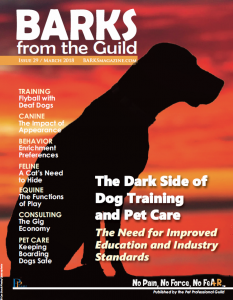 I have been waiting for an organization of pet professionals to take a stand against the use of shock collars since 2002, so when PPG launched the Shock-Free Coalition on September 25, 2017, I was more than ready to sign the pledge to eliminate shock devices
I have been waiting for an organization of pet professionals to take a stand against the use of shock collars since 2002, so when PPG launched the Shock-Free Coalition on September 25, 2017, I was more than ready to sign the pledge to eliminate shock devices  from the supply and demand chain. However, I also knew that signing the pledge, while an important step, was not going to be sufficient to stop the use of shock collars. Signing the pledge is just the beginning of what will very likely be a long campaign.
from the supply and demand chain. However, I also knew that signing the pledge, while an important step, was not going to be sufficient to stop the use of shock collars. Signing the pledge is just the beginning of what will very likely be a long campaign.
In addition to signing the pledge, as many of us as possible must commit to educating others in our profession, other pet professionals, and pet parents about the dangers of shock. This educational effort will also require that many of us become advocates and publicly speak on behalf of dogs, who cannot speak for themselves.
Critical elements of being an advocate involve writing and public speaking and presenting logical and scientifically-based arguments for our position while being respectful of those that disagree with us. I know there are many reasons that not everyone in our profession is comfortable being an advocate. Some may have a fear of public speaking, an instinct to avoid confrontation of any kind, or a concern about how taking a position on what some consider to be a controversial issue, may affect their relationship with current and prospective clients and their business’s bottom line. These are all real concerns, and if they describe you, I understand. On the other hand, if you want to try to overcome these issues, know that there are others ready to help you.
How, then, do you get over the concern regarding how 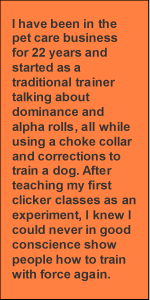 publicly taking a position may affect your business? This is not always easy. I have been in the pet care business for 22 years and started as a traditional trainer talking about dominance and alpha rolls, all while using a choke collar and corrections to train a dog. After teaching my first clicker class as an experiment, I knew I could never in good conscience show people how to train with force again. I threw out our existing curriculum, scrambled to create a new one, and our classes became force-free, pain-free, and fear-free. This change was made in spite of the fact that I feared we would lose many of our training clients and veterinary referrals.
publicly taking a position may affect your business? This is not always easy. I have been in the pet care business for 22 years and started as a traditional trainer talking about dominance and alpha rolls, all while using a choke collar and corrections to train a dog. After teaching my first clicker class as an experiment, I knew I could never in good conscience show people how to train with force again. I threw out our existing curriculum, scrambled to create a new one, and our classes became force-free, pain-free, and fear-free. This change was made in spite of the fact that I feared we would lose many of our training clients and veterinary referrals.
I have to thank my friend Gail Fisher of All Dogs Gym in Manchester, New Hampshire for giving me the courage to do this. Fisher had a massive investment in correction-based training, both as an author and pet care professional, yet she made a complete transition to clicker training because she believed it was the best option for her clients and their dogs. As a result of my choosing to transition entirely to clicker training, my business has grown, and most of the veterinarians in our community became convinced of our kind, compassionate approach’s efficacy. Also, I could sleep at night because I was no longer teaching people to “strangle their dog.”
While I am comfortable speaking, writing, and arguing for a just cause, I know that ending shock will require similar actions by many of us. I am a firm believer in the concepts, “think globally, act locally” and that “many hands make light work.” I thus decided to launch a Shock-Free Coalition in Maine where I live.
My first step was to contact all the PPG members in Maine and to invite them to join me. This was a logical first step as PPG members have already indicated their commitment to ending the use of shock collars simply by joining the organization. Indeed, Section One of PPG’s Guiding Principles states: “Pet Professional Guild members understand force-free to mean: no shock, no pain, no choke, no fear, no physical force, no compulsion-based methods are employed to train or care for a pet.” (Pet Professional Guild, 2017). Like I said, all PPG members have essentially committed to the pledge simply by becoming members.
I know many pet professionals in Maine who are not yet PPG members. However, because I was confident that they felt the same way about shock collars as I did, I invited them to join our cause. My second recommendation, then, is to contact other pet professionals in your community whom you know are already opposed to shock. If you get them to join your coalition, invite them to join PPG as well.
I have taken several actions as an individual, all of which 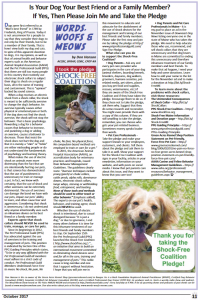 anyone can do, and I suspect many PPG members have already done too:
anyone can do, and I suspect many PPG members have already done too:
- I sent out a press release with the news that my business, Green Acres Kennel Shop, has joined the Shock-Free Coalition. PPG makes this easy for us by offering a template.
- I wrote an article for the October 2017 issue of Downeast Dog News titled Is Your Dog Your Best Friend or a Family Member? If Yes, Then Please Join Me and Take the Pledge which I also published on my blog. If you have a dog newspaper in your community, write an article and submit it. If you do not have a newspaper that focuses on dogs or pets, try your local weekly or daily paper. If you do not have a blog, start one.
I shared a link to my article, as well as an older article I had written (The Unintended Consequences of Shock Collars), on my personal Facebook page as well as my business pages ( https://www.facebook.com/GreenAcresKennelShop/ & https://www.facebook.com/WoofMeowShow/ & https://www.facebook.com/WordsWoofsandMeows/ ), and continue to do so on a regular basis. Share your articles and blogs on why shock-free is important, and do it more than once. There are some great software tools available to allow you to post to Facebook and Twitter on an automated basis. My favorite is Post Planner.
- I included an article on the Shock-Free Coalition in the email newsletter my business sends to our clients and asked them to join us by taking the pledge. No matter how you stay in touch with your clients, keep them aware of the shock-free movement and your part in it.
- I changed my profile picture and cover on my Facebook page, and those of my business pages, to encourage people to take the pledge. This is one of the easiest ways you can make others aware of the shock-free movement and your commitment to it.
 I put up signage in our store promoting the Shock-Free Coalition and our commitment to the “No Pain, No Force, No Fear” philosophy. I also include PPG’s “No Pain, No Force, No Fear” logo on much of our printed literature.
I put up signage in our store promoting the Shock-Free Coalition and our commitment to the “No Pain, No Force, No Fear” philosophy. I also include PPG’s “No Pain, No Force, No Fear” logo on much of our printed literature.- There is a large banner hanging on the lower half of our outdoor sign, proclaiming we have joined the Shock-Free Coalition.
The following are things I have done to promote the Shock-Free Coalition as an individual which may not be as easy for others, but they are worth exploring:
- I invited Niki Tudge, PPG’s founder, to be a guest on my weekly radio show, The Woof Meow Show, where we discussed the shock-free movement. If you do not have a radio show, find out who in your community does. Community-based radio programs are always looking for guests. In addition to hosting Tudge on my show, I have also been a guest on two other shows in our area that gave me an opportunity to discuss why shock-free is so important.
- My co-host and I recorded a radio show/podcast titled The Unintended Consequences of Shock Collars as a companion piece to my blog post with the same title. I find it valuable to provide information in a variety of formats as some people prefer to listen to something rather than reading.
Our first group project in Maine was to place a full-page, color advertisement in the November 2017 issue of Downeast Dog News, a state-wide dog-centric newspaper. A total of 12 pet care professionals participated in the ad where we publicly announced our commitment to ending the use of shock and invited other pet care professionals and pet parents to join us. Since then, we have had an animal rescue organization join our cause, and I am in the midst of discussions with a large animal shelter and two veterinarians about joining us for our next advert.
My eventual hope is that other pet care professionals who might be on the fence will see the benefit to their bottom line if they take the pledge.
In addition to the ad, I have cobbled together a website describing our coalition’s mission, providing a directory of shock-free pet professionals for pet parents, and announcing our next educational and advocacy events. Meanwhile, we are discussing our next steps as to how to grow our group and get more people actively participating.
If you have already signed the Shock-Free Pledge, thank you! If you have not signed it yet, it is imperative that you do so.
All of us that want to see shock eliminated as an option in pet training and behavior modification have much work to do. I will try to keep you informed of what we are doing in Maine, sharing what works and what does not. In the meantime, please share your stories with other PPG members so we can all benefit from what others are doing. Together
we can make the world shock-free!
References
Pet Professional Guild. (2017). Guiding Principles. Available at: bit.ly/PPGGuidingPrinciples
Resources
Hanson, D. (2017, October 1). Is Your Dog Your Best Friend or a Family Member? If Yes, Then Please Join Me and Take the Pledge. Available at: http://bit.ly/BestFriendsAndShock
Hanson, D. (2017, October 22). The Unintended Consequences of Shock Collars. Available at: http://bit.ly/ShockCollars
Shock-Free Coalition: https://www.shockfree.org/
Shock-Free Coalition News Release Template: bit.ly/ShockFreeCoalitionNews
Say No To Shock! (A List of Scientific Articles and More) – http://bit.ly/SayNoToShock
Shock-Free Coalition of Maine Facebook Page: http://bit.ly/ShockFreeMEFB
Shock-Free Coalition Sign the Pledge: https://www.shockfree.org/Pledge
Maine Pet Care Professionals We Recommend – http://bit.ly/MEPetPros
The Woof Meow Show (Producer). (2017, September 30). The Pet Professional Guild and the Shock-Free Coalition with Niki Tudge [Audio Podcast]. Available at: http://bit.ly/PodCastShockFree-NikiTudge-2017
The Woof Meow Show. (Producer). (2017, October 21). The Unintended Consequences of Shock Collars [Audio Podcast]. Available at: http://bit.ly/ShockPodcast
Don Hanson ACCBC BFRAP CDBC CPDT-KA is the co-owner of the Green Acres Kennel Shop ( greenacreskennel.com ) in Bangor, ME where he has been helping people with their pets since 1995. He is a Bach Foundation Registered Animal Practitioner (BFRAP), Certified Dog Behavior Consultant (CDBC), Associate Certified Cat Behavior Consultant (ACCBC) and a Certified Professional Dog Trainer (CPDT-KA). Don is a member of the Pet Professional Guild (PPG) and is committed to PPG’s Guiding Principles and the Pain-Free, Force-Free, and Fear-Free training, management, and care of all pets. Don produces and co-hosts a weekly radio show and podcast, The Woof Meow Show, that airs on Z62 Retro Radio WZON (AM620) and WKIT 103.3-HD3 and is streamed at http://bit.ly/AM620-WZON every Saturday at 9 AM. Podcasts of the show are available at http://woofmeowshow.libsyn.com/, the Apple Podcast app, and at Don’s blog: www.words-woofs-meows.com. The opinions in this post are those of Don Hanson.
©01MAR18, Donald J. Hanson, All Rights Reserved
< Click for Copyright and Use Policy >
Shared Article – Thank You, PPG, and Gus Too!
By Don Hanson, PCBC-A
A version of this article was first published in the May 2017 Issue of BARKS from the Guild
< This is short link to this article on my blog
< http://bit.ly/ThanksPPG-Gus >
I was not allowed to get my first puppy until I was a junior in high school in January 1975. I am not sure why my parents succumbed to my pleas after twelve years, but they did. When I purchased my cute little puff of black fur, a Keeshond/Poodle, and we never caught the father mix, neither the pet store nor the veterinarian suggested training her. Other than some basic housetraining, Trivia had no real training  during her life. She was a happy dog who liked everyone and was with us for 14 wonderful years. However, I believe that the life Trivia and I shared could have been much better if I knew what I know now. I am thankful that PPG exists today because they are an excellent resource for anyone who has just adopted their first dog.
during her life. She was a happy dog who liked everyone and was with us for 14 wonderful years. However, I believe that the life Trivia and I shared could have been much better if I knew what I know now. I am thankful that PPG exists today because they are an excellent resource for anyone who has just adopted their first dog.
My first venture into training a dog was when my wife Paula and I got our first puppy as a couple. It was the spring of 1991, we had just purchased our second home, and we decided we needed something to shed on the carpets; just kidding! So we did some research, and on the advice of Paula’s employer, a veterinarian, we went looking for a Cairn Terrier puppy. We found one and named him Laird Gustav MacMoose or “Gus” because he just acted like a “Gus.” Then, on the advice of Paula’s boss, we immediately enrolled ourselves and twelve-week-old Gus in a

puppy kindergarten class offered by the local dog club. We also purchased and read both Mother Knows Best and How to Be Your Dog’s Best Friend because those were the two dog training books that were recommended at the time.
Our first night in puppy class was a complete disaster. First, things went downhill when I was told to command Gus to sit, and Gus failed to comply. Now, this was neither a big deal to us nor a surprise, as Paula and I knew that Gus had not received any training. However, it was a massive deal for the two instructors. In no uncertain terms, they told me that Gus was exerting his dominance and that I had to alpha-roll him to show him that I was the alpha. The alpha role was precisely what the books we were reading recommended. So not knowing any better, I did as I was told. Then, as I grabbed Gus by the scruff and pinned him, he immediately began thrashing around underneath me, growling and snapping and trying to connect his teeth with any part of me so I would let him go. I know now that he was terrified.
When I was told to grab his muzzle and “hold it shut,” I again, naively, complied. That is when Gus’ taught me that the dog’s teeth will ALWAYS be faster than the human’s hand. Gus instinctively sunk his canines deep into my palm. I said something inappropriate and immediately let go and began to bleed profusely all over the training room floor. As one instructor ran to get me some ice for my hand, the other gave me a dirty look and continued teaching the class. I handed the leash to Paula, disappointed in Gus and myself. I know now that the physical pain I experienced was nothing compared to the emotional trauma experienced by Gus.
After we went home, it was evident that the relationship between Gus and me was severely damaged. I was no longer being asked to “throw the ball” by the  Cairn with a tennis ball in his mouth and a vibrating tail. Gus did not trust me, and I did not trust him. I let Paula handle him in the remainder of his puppy classes. When she went on to the next level of classes with a different training club, I elected not to participate. I am thankful that PPG exists and today can guide a young couple with a dog to find a qualified trainer that will teach them how to create and maintain a relationship based on trust and positive reinforcement. I am grateful that PPG can also recommend which books to read and, equally important, which to avoid.
Cairn with a tennis ball in his mouth and a vibrating tail. Gus did not trust me, and I did not trust him. I let Paula handle him in the remainder of his puppy classes. When she went on to the next level of classes with a different training club, I elected not to participate. I am thankful that PPG exists and today can guide a young couple with a dog to find a qualified trainer that will teach them how to create and maintain a relationship based on trust and positive reinforcement. I am grateful that PPG can also recommend which books to read and, equally important, which to avoid.
Over time Gus and I learned to trust one another again, and training became something we both enjoyed. So when Paula and I adopted a second dog, we decided to take Gus and Shed to some additional classes. We were fortunate to discover Dr. Patricia McConnell and her Dog’s Best Friend Training facility, where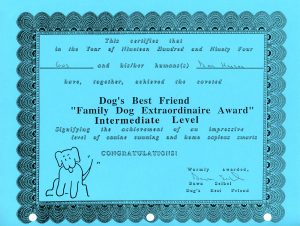 we learned about the wonders of reward-based training. I worked with Gus, and Paula handled Shed, and the four of us learned a great deal but more importantly, we also had lots of fun.
we learned about the wonders of reward-based training. I worked with Gus, and Paula handled Shed, and the four of us learned a great deal but more importantly, we also had lots of fun.
Gus eventually became the catalyst for our getting into the pet care services industry. His behavioral issues, he became reactive when people tried to leave our home, led to my interest in aggression and reactivity. His bladder and urinary problems, determined to be due to diet, resulted in our preoccupation with pet nutrition. Finally, when Gus developed epilepsy, he sparked our interest in complementary medicine. Thank you, Gus. You were quite the teacher as well as being a fabulous furry friend.
In the fall of 1995, we moved from Wisconsin to Maine after purchasing the Green Acres Kennel Shop. Paula and I jumped right into our new business. 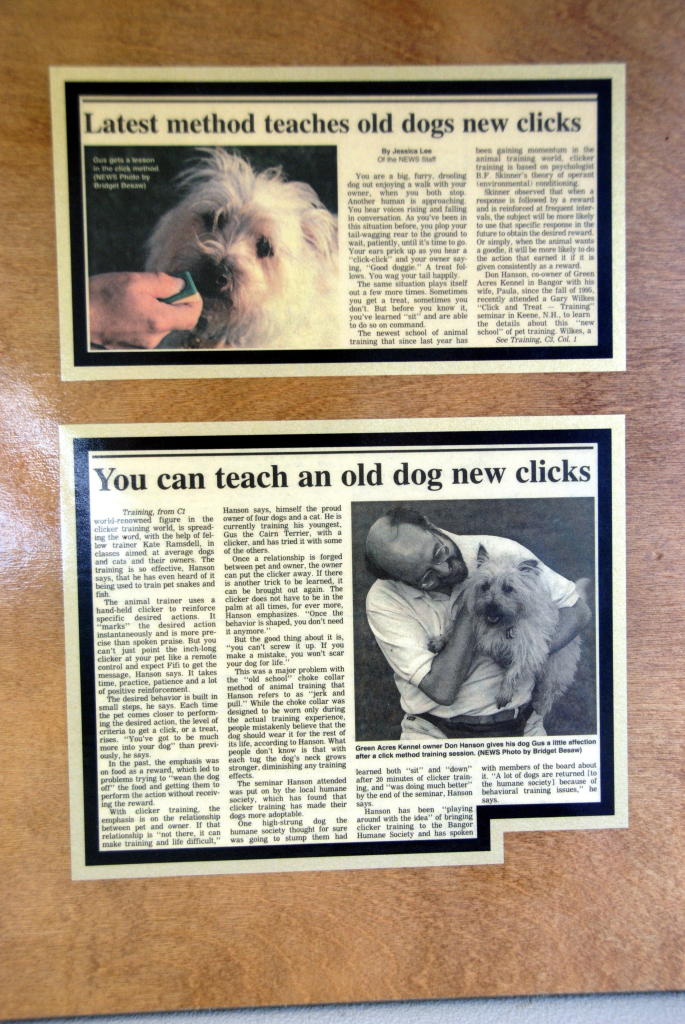 Having learned the value of professional organizations in my previous career, we discovered and joined the American Boarding Kennel Association (ABKA) and the Association of Pet Dog Trainers (APDT). Through the APDT email list, I met several people who remain close friends.
Having learned the value of professional organizations in my previous career, we discovered and joined the American Boarding Kennel Association (ABKA) and the Association of Pet Dog Trainers (APDT). Through the APDT email list, I met several people who remain close friends.
I also started reading every book I could find on dogs, behavior, husbandry, nutrition, and training. I also began attending seminars and worked with our existing trainer to learn my craft.
After attending a series of seminars on clicker training in 1997, I started working with Gus using the clicker. I sent a press release to the Bangor Daily News, which sent out a reporter to interview me. They published an article about Gus, me, and clicker training, including two photos! Immediately we were inundated with people asking about clicker training classes. I realized I had to scramble to develop those classes. Thankfully, I discovered what I believe was Dr. Deborah Jones’s first publication on clicker training, a course curriculum. In a few weeks, we started our first pilot classes, and by the end, I decided we would use the clicker in all future classes. As you can see, Gus was quite an influence.
In the fall of 1998, I attended my first APDT conference in Valley Forge, PA, and stepped right into my first debate over shock collars. A shock collar company was exhibiting at the APDT trade show, and there was a significant discussion as to whether or not they should be allowed to do so. A group of us from the APDT email list, known as the “Treat Slinging Weenies,” complete with t-shirts, expressed our displeasure. That was my first experience in advocacy in the dog world, and the experience rewarded me. After that conference, APDT adopted a policy prohibiting the promotion of shock collars at future events.
Three years later, I was encouraged to run for the APDT Board of Trustees and started my first three-year term on the Board in 2002. Hoping to expand upon the ban on promoting shock collars at the conference,e in July of 2002, I proposed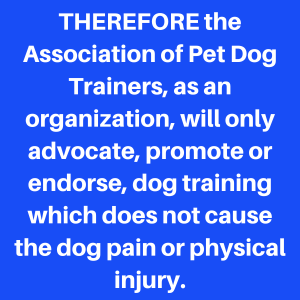 that the APDT adopt a resolution defining dog-friendly dog training. At the time, the term “dog-friendly” was used in both the APDT Vision and Mission statements.
that the APDT adopt a resolution defining dog-friendly dog training. At the time, the term “dog-friendly” was used in both the APDT Vision and Mission statements.
I based my resolution to clarify what APDT meant by “dog-friendly on a position by the World Small Animal Veterinary Association WSAVA stating, “No companion animal should be trained in such a way that is detrimental to its health and welfare, especially by methods which force it to exceed its natural capacities or strength by employing artificial training aids which may cause physical injury, pain, suffering or distress.” Since a survey of the APDT membership indicated that 65% of the members responding believed that APDT should advocate only positive training approaches, and 57% of the respondents believed APDT should NOT be impartial toward training methods. I naively thought the adoption of my proposal would be a “No Brainer.”
My proposal ended by stating, “THEREFORE, it is only logical to conclude that “dog friendly-training” does not include the use of tools or methods that are intended to cause pain or physical injury and that a majority of the membership support this conclusion. And THEREFORE, the Association of Pet Dog Trainers, as an organization, will only advocate, promote or endorse, dog training which does not cause the dog pain or physical injury.” Sadly, my motion died for lack of a second. I was very disappointed that no one was willing to discuss my proposal.
I served on the APDT Board for two consecutive terms waiting for an opportunity to get APDT to take a more assertive position on dog-friendly practices. Still, it never happened during those six years. I was again encouraged to run for the Board in 2010 and was elected to another three-year term. Sadly, it was evident the APDT was still not ready to take a stand on the use of aversives.
In 2014 I took my first serious look at PPG, applied for membership, and let my membership in the APDT expire. Earlier I stated that I believe professional organizations are essential. To me, membership in such an organization demonstrates an individual’s and a business’s commitment to the best practices of their profession. For that reason, as soon as a team member at Green Acres or ForceFreePets completes their probationary training period, I enroll them as a member of the PPG no matter what role they play here. Every trainer, pet care technician, groomer, customer service associate, and manager is a PPG member and is expected to live up to the PPG guiding principles. It is a condition of employment.
I am very thankful that I finally found a cohort of like-minded pet care professionals committed to the same things I am and their willingness to support those beliefs publicly. Thank you, PPG, and thank you, Niki Tudge.
I continue to believe that it is necessary to advocate for the humane treatment of pets by all pet care professionals. I became an email list manager for a group of boarding kennel and daycare operators in 1996. In 2006, some members of the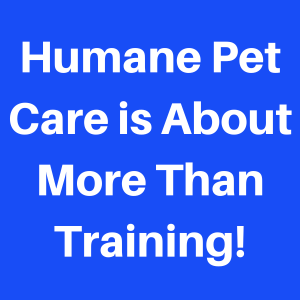 list began discussing how they used squirt bottles, spray nozzles on hoses, and anti-bark shock collars on their guests to control barking. I was appalled and made being pet-friendly a requirement of being a member of the list. Around the same time, a client informed me that a kennel in our area used a shock collar on their dog while the dog was in the care of the facility. This was something the dog’s owners would never have approved, and they were rightfully very upset.
list began discussing how they used squirt bottles, spray nozzles on hoses, and anti-bark shock collars on their guests to control barking. I was appalled and made being pet-friendly a requirement of being a member of the list. Around the same time, a client informed me that a kennel in our area used a shock collar on their dog while the dog was in the care of the facility. This was something the dog’s owners would never have approved, and they were rightfully very upset.
As a result, I decided Green Acres Kennel Shop needed to be proactive about stating precisely what we mean by “Pet Friendly.” As a result, we published our first position statement entitled “Green Acres Is A “Pet-Friendly Facility” (https://www.greenacreskennel.com/blog/2006/02/01/green-acres-first-statement-on-being-a-pet-friendly-facility/) in February of 2002.
In the Spring of 2022, we took another step forward in the goal of a world where all pet care professionals are humane, ethical, and transparent in their policies 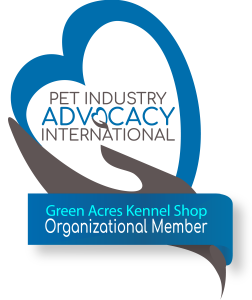 and practices by applying to become an organizational member of Pet Industry Advocacy International (PIAI). Membership in PIAI is open to any pet professional organization that currently practices and advocates for ethical, humane science-based services that have been in business for at least three years and have a minimum of ten members/employees/volunteers. Green Acres Kennel Shop is the first boarding, daycare, and grooming facility to be accepted by PIAI. I encourage all eligible organizations and facilities to become PIAI members as it’s what pets need and what most people with pets, expect of those caring for their pets.
and practices by applying to become an organizational member of Pet Industry Advocacy International (PIAI). Membership in PIAI is open to any pet professional organization that currently practices and advocates for ethical, humane science-based services that have been in business for at least three years and have a minimum of ten members/employees/volunteers. Green Acres Kennel Shop is the first boarding, daycare, and grooming facility to be accepted by PIAI. I encourage all eligible organizations and facilities to become PIAI members as it’s what pets need and what most people with pets, expect of those caring for their pets.
Resources
Green Acres’ First Statement on Being A Pet Friendly-Facility – http://blog.greenacreskennel.com/2006/02/01/green-acres-first-statement-on-being-a-pet-friendly-facility/
Green Acres Kennel Shop Position Statement on Pet-Friendly, Force-Free Pet Care – http://bit.ly/GAKS_Pet-Friendly
Green Acres Kennel Shop Position on the Use of Dominance and Punishment for the Training and Behavior Modification of Dogs – http://bit.ly/GAKS-Pos-NoPain-NoForceNoFear
Pet Professional Guild Guiding Principles – http://www.bit.ly/2mUCTqN
Pet Professional Guild – Pet Training, Management and Care: We Now Know Enough to Stop Shocking Our Pets – An Open Letter to Pet Industry Representatives Regarding the Use of Shock in Animal Training – http://bit.ly/2mUEj4Q
Things I Wish I Had Known Before I Started Training Dogs – Gus, the Dominance Myth, An Alpha Roll, and a Damaged Relationship – http://bit.ly/Things-Gus-Dominance
Dominance: Reality or Myth – http://bit.ly/Dominance-RealityorMyth
________________________________________________________________________
Don Hanson lives in Bangor, Maine, where he is the co-owner of the Green Acres Kennel Shop ( greenacreskennel.com ) and the founder of ForceFreePets.com, an  online educational resource for people with dogs and cats. He is a Professional Canine Behavior Consultant (PCBC-A) accredited by the Pet Professional Accreditation Board (PPAB) and a Bach Foundation Registered Animal Practitioner (BFRAP). Don is a member of the Pet Professional Guild (PPG), serving on the Board of Directors and Steering Committee and chairing the Advocacy Division. He is also a founding director of Pet Advocacy International (PIAI). In addition, Don produces and co-hosts The Woof Meow Show podcast, available at http://bit.ly/WfMwPodcasts/, the Apple Podcast app, and Don’s blog: www.words-woofs-meows.com. The opinions in this article are those of Don Hanson.
online educational resource for people with dogs and cats. He is a Professional Canine Behavior Consultant (PCBC-A) accredited by the Pet Professional Accreditation Board (PPAB) and a Bach Foundation Registered Animal Practitioner (BFRAP). Don is a member of the Pet Professional Guild (PPG), serving on the Board of Directors and Steering Committee and chairing the Advocacy Division. He is also a founding director of Pet Advocacy International (PIAI). In addition, Don produces and co-hosts The Woof Meow Show podcast, available at http://bit.ly/WfMwPodcasts/, the Apple Podcast app, and Don’s blog: www.words-woofs-meows.com. The opinions in this article are those of Don Hanson.
©3OCT22, Donald J. Hanson, All Rights Reserved
< Click for Copyright and Use Policy >
